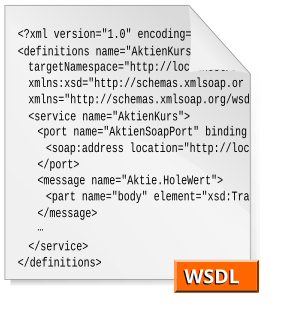
SOAP is a messaging protocol specification for exchanging structured information in the implementation of web services in computer networks. Its purpose is to provide extensibility, neutrality, verbosity and independence. It uses XML Information Set for its message format, and relies on application layer protocols, most often Hypertext Transfer Protocol (HTTP), although some legacy systems communicate over Simple Mail Transfer Protocol (SMTP), for message negotiation and transmission.
The term Web service (WS) is either:
Camunda Platform is an open-source workflow and decision automation platform. Camunda Platform ships with tools for creating workflow and decision models, operating deployed models in production, and allowing users to execute workflow tasks assigned to them. It is developed in Java and released as open-source software under the terms of Apache License.
The Web Services Business Process Execution Language (WS-BPEL), commonly known as BPEL, is an OASIS standard executable language for specifying actions within business processes with web services. Processes in BPEL export and import information by using web service interfaces exclusively.

Business process modeling (BPM) in business process management and systems engineering is the activity of representing processes of an enterprise, so that the current process may be analyzed, improved, and automated. BPM is typically performed by business analysts, who provide expertise in the modeling discipline; by subject matter experts, who have specialized knowledge of the processes being modeled; or more commonly by a team comprising both. Alternatively, the process model can be derived directly from events' logs using process mining tools.
A business rules engine is a software system that executes one or more business rules in a runtime production environment. The rules might come from legal regulation, company policy, or other sources. A business rule system enables these company policies and other operational decisions to be defined, tested, executed and maintained separately from application code.

The XML Process Definition Language (XPDL) is a format standardized by the Workflow Management Coalition (WfMC) to interchange business process definitions between different workflow products, i.e. between different modeling tools and management suites. XPDL defines an XML schema for specifying the declarative part of workflow / business process.
YAWL is a workflow language based on workflow patterns. The language is supported by a software system that includes an execution engine, a graphical editor and a worklist handler. The system is available as Open source software under the LGPL license.
Business Process Modeling Language (BPML) is an XML-based language for business process modeling. It was maintained by the Business Process Management Initiative (BPMI) until June 2005 when BPMI and OMG announced the merger of their respective Business Process Management (BPM) activities to form the Business Modeling and Integration Domain Task Force. It is deprecated since 2008. BPML was useful to OMG in order to enrich UML with process notation.
The Business Process Definition Metamodel (BPDM) is a standard definition of concepts used to express business process models, adopted by the OMG. Metamodels define concepts, relationships, and semantics for exchange of user models between different modeling tools. The exchange format is defined by XSD and XMI, a specification for transformation of OMG metamodels to XML. Pursuant to the OMG's policies, the metamodel is the result of an open process involving submissions by member organizations, following a Request for Proposal (RFP) issued in 2003. BPDM was adopted in initial form in July 2007, and finalized in July 2008.
Workflow Management Coalition (WfMC) is a consortium formed to define standards for the interoperability of workflow management systems.
A workflow management system provides an infrastructure for the set-up, performance and monitoring of a defined sequence of tasks, arranged as a workflow application.
jBPM is an open-source workflow engine written in Java that can execute business processes described in BPMN 2.0. jBPM is a toolkit for building business applications to help automate business processes and decisions. It's sponsored by Red Hat, part of the JBoss community and closely related to the Drools and OptaPlanner projects in the KIE group. It is released under the ASL by the JBoss company.
Business process management (BPM) is the discipline in which people use various methods to discover, model, analyze, measure, improve, optimize, and automate business processes. Any combination of methods used to manage a company's business processes is BPM. Processes can be structured and repeatable or unstructured and variable. Though not required, enabling technologies are often used with BPM.

The Web Services Description Language is an XML-based interface description language that is used for describing the functionality offered by a web service. The acronym is also used for any specific WSDL description of a web service, which provides a machine-readable description of how the service can be called, what parameters it expects, and what data structures it returns. Therefore, its purpose is roughly similar to that of a type signature in a programming language.

Bizagi is a privately owned software company established in 1989 with headquarters in the UK, and offices in USA, Spain & Latin America. Its name is a portmanteau of "business" and "agility".
Imixs Workflow is an Open-Source-Project, providing technologies for building Business Process Management solutions. The project focus on human based workflows used to execute and control workflows in organisations and enterprises. In difference to task-oriented workflow engines, which focus on automated program flow control (tasks), Imixs Workflow is a representative of an event-based workflow engine. Here, the engine controls the status of a process instance within a defined state-diagram. By entering an event, the state of a process instance can be abandoned or changed. In human-centric workflow engines, events usually occur by an interaction of the actor with the system, for example by approving or rejecting a business transaction. They can also be triggered by scheduled events. An example of this is an escalation of an unfinished task.
WorkflowGen is a web-based low-code business application creation solution developed by Advantys. As a workflow software and business process management (BPM) solution, WorkflowGen enables organizations to automate human and system-based processes via a visual interface in a low programming environment.